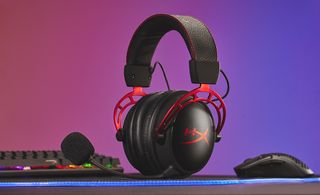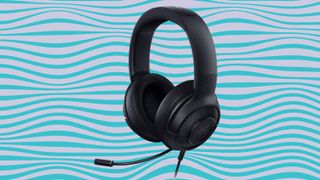I review gaming headsets for a living — and these are the most comfortable
Audio quality only goes so far

Today’s best gaming headsets come with more features than you can shake a fighting stick at. If you’re willing to drop $100 or more on a high-end peripheral, you might get separate volume and chatmix dials, wireless connectivity (USB and Bluetooth flavors), programmable software, surround sound, a detachable mic, wireless charging, up to 300 hours of battery life and more.
While these are all nice to have, there are really only two things a great gaming headset needs – and good sound quality is arguably the less important one.
Staying comfortable
To give a little background information, I’ve been reviewing gaming headsets since 2016, and have evaluated a few dozen different models in that time. From Razer to Logitech to SteelSeries to Turtle Beach to Roccat and beyond, I’ve seen – and heard – the best and worst of what the PC gaming peripheral market has to offer. During that time, I’ve learned that the single most important thing a gaming headset can offer is a comfortable fit.

If you read through a Tom’s Guide gaming headset review — let’s use the Razer Kraken V3 Pro as an example — notice that Design and Comfort are the first two things we evaluate. Performance comes after those two categories, and that’s not an accident.
The fact is, I learned early on that impeccable sound quality doesn’t actually mean much if you can’t stand to wear the headset for more than an hour at a time. Everyday music headphones can sometimes get away with mildly uncomfortable fits, as people tend to use them in short bursts – commuting, errands, chores and so forth.
Gaming headphones, however, are long-haul accessories. According to Limelight, which provides content delivery platforms for large companies, the average gaming session is about two hours long. Remember that “average” is the operative word here. Limelight also observed that four-hour gaming sessions are not uncommon, and 10-hour sessions are not unheard of.
Believe me when I say that comfort starts to trump sound quality relatively quickly after the one-hour mark.
To be fair, I have nothing but high praise for gaming headsets that make sound quality a high priority. For too long, “gaming headset” was almost a synonym for “underwhelming headset with a boom mic.” Companies have made huge strides in audio quality over the past 10 years, particularly manufacturers such as Astro and HyperX. If you have a few hundred dollars at your disposal, you can buy a headset that successfully splits the difference between gaming performance and musical fidelity.
Still, when it comes to headsets, physics is always going to work against you. A headset, by definition, applies pressure. The headband applies pressure to the top of your head, which helps the device stay put. The earcups apply pressure to your ears, which helps create a firm seal. This pressure can cause discomfort over time, particularly if you wear glasses. There’s also not much you can do to stop it, short of playing with speakers, or switching to earbuds, each of which has its own set of problems.
How to choose a comfortable gaming headset
There is admittedly a huge point of contention in the “buy the most comfortable gaming headset” argument, namely that no two gamers have the exact same definition of comfort. Between plastic headbands, steel headbands, elastic headbands, notches, no notches, foam earcups, pleather earcups, boom mics, removable mics, retractable mics and so forth, there are dozens of different ways a headset can feel.

As a reviewer, I can tell you what I find comfortable (elastic headbands, foam earcups, retractable microphones, for the record), but explaining how a device feels in general is usually the toughest part of a review. Audio quality is somewhat subjective, too, but if a soundscape is muffled, or metallic, or distant, or unbalanced, or too loud, or too quiet, most listeners can at least agree on that.
One of the best ways to test headsets is simply to go to your local electronics store. Many big box stores, such as Best Buy, have display models that you can see, touch and (if you’re not too squeamish) try on. If you find one that’s especially comfortable, then you can simply buy that model on the spot. Problem solved.
If you don’t have access to try-on models, however, it’s a little more challenging to find a comfortable gaming headset. I would start by playing a video game with your go-to set of headphones for at least an hour. At the end of your session, take stock of your ears. Are they sweaty? Do you feel any pain? If so, where? How often did you need a mic? You should also consider whether you’ll share your headphones with a roommate or spouse, since elastic or notched headbands make it easy to find your perfect fit every time.
My top gaming headset picks for comfort
Although I can’t recommend gaming headsets for every conceivable comfort preference, I can discuss a few that I’ve personally enjoyed. These models also have significant design differences, so it should give you an idea of where to start looking.

First off, my absolute favorite gaming headset on the market right now is the SteelSeries Arctis 7X. They use the signature SteelSeries elastic headband, meaning that you don’t have to adjust anything manually. You simply put the headset on, and it adjusts to the size and shape of your head. The Arctis 7X is actually a perfect example of “comfort over sound quality,” as you can get much better sound from gaming headsets with 50 mm drivers, such as the Logitech G Pro X Wireless. But I’d rather wear the Arctis 7X for protracted gaming sessions.
If you prefer a tighter fit with more pleather-style earcups, the HyperX Cloud Alpha Wireless is a strong contender that just came out recently. Not only does the Cloud Alpha Wireless sound great, but it also offers up to 300 hours of battery life, which is unprecedented for a gaming headset. I couldn’t say whether it’s comfortable to wear for 300 hours straight, but someone should at least give it a try.
Finally, if you’re looking for something a little more bare-bones, the Razer Kraken X is worth considering. The headset weighs only 8.8 ounces. This makes it a little easier on the top of the head than larger devices, which can weigh close to a pound. The Kraken X is also a good litmus test for how badly you want a removable or retractable mic, since its flexible, nonremovable mic will never entirely leave your line of sight. Some gamers don’t mind; others (like me) find it insufferable.
Whatever you choose, remember that sound quality will impress you for an hour or two; comfort will last your entire play session. Ideally, you’ll want a headset with a mix of both. For that, you can consult our list of the best gaming headsets.
Sign up to get the BEST of Tom’s Guide direct to your inbox.
Upgrade your life with a daily dose of the biggest tech news, lifestyle hacks and our curated analysis. Be the first to know about cutting-edge gadgets and the hottest deals.
Marshall Honorof is a senior editor for Tom's Guide, overseeing the site's coverage of gaming hardware and software. He comes from a science writing background, having studied paleomammalogy, biological anthropology, and the history of science and technology. After hours, you can find him practicing taekwondo or doing deep dives on classic sci-fi.

